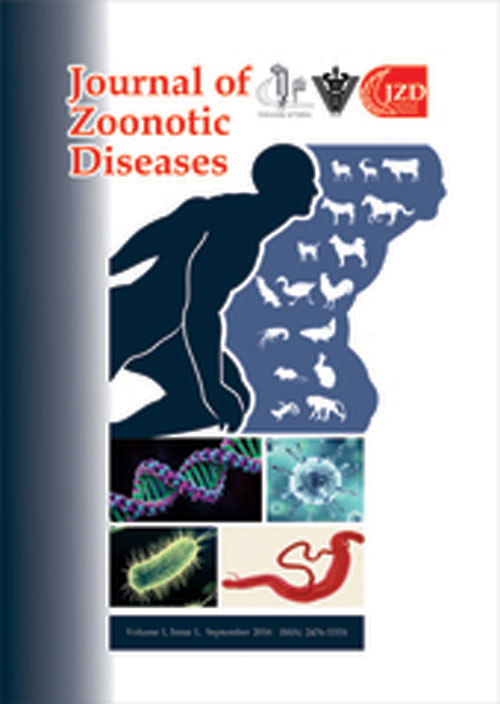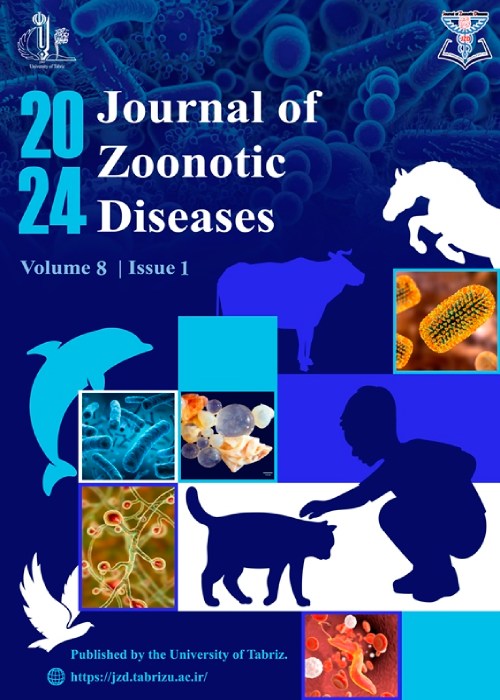فهرست مطالب

Journal of Zoonotic Diseases
Volume:6 Issue: 1, Winter 2022
- تاریخ انتشار: 1401/02/09
- تعداد عناوین: 6
-
-
Pages 1-10
The Housefly (Musca domestica Linnaeus, 1758) lives in close proximity to humans, posing a variety of health risks. They are mechanical vectors capable of spreading an arraying of infections and annoy humans. More than 100 types of pathogens, including bacterial, viral, and protozoan, are transmitted by houseflies, and in this review, we describe 5 of them: Cholera, Anthrax, Shigella, ORF Virus, and Ascariasis. Cholera is a rigorous flux ailment initiated via the Vibrio cholerae bacteria contaminating the intestines. The ailment is often modest or does not present symptoms, but it can also be dangerous and lead to death, while anthrax is a harmful infective illness brought about by Bacillus anthracis. Shigellosis (Shigella infection) is a gastrointestinal ailment caused by Shigella spp. Bloody diarrhea is the most common sign of shigella infection. Houseflies are a severe health hazard for humans, causing discomfort, disease, and even death. Studies that assess the impact of Houseflies on humans were briefed. Articles on PubMed, Google Scholar, and other online reports, 50 in number, were reviewed.The genesis and life cycle of houseflies, their mode of disease transmission, commonly transmitted diseases are all discussed in this paper. Biological, chemical, and cultural control are some of the common control strategies discussed.
Keywords: Housefly, Cholera, Anthrax, Shigellosis, Control -
Pages 11-16Zoonotic infections pose a significant public health threat. Because of the close contact between diseases of domestic animals and humans, the current study aimed to determine the prevalence of zoonotic gastrointestinal parasitic infections in goats in three selected abattoirs in the Makurdi metropolis. For this purpose, a total of 150 fecal samples were collected from July through October 2013, using a random sampling method. Wet mount and Formol-ether sedimentation techniques were used to prepare the specimens, which were subsequently examined using a compound microscope (40 X) to identify characteristic eggs of the parasites in goats. The Chi-Square test at a significant level of 0.05 was used for data analyses. Of the 150 fecal specimens examined, 143 (95.33%) were infected with at least one gastrointestinal parasite. Altogether, eight parasites were identified among the 143 positive specimens- Strongyloides papillosus 43 (28.7%), Fasciola gigantica 37 (24.7%), Trichuruis spp 25 (16.7%), Giardia spp 13 (8.7%), Marshallagia marshalli 9 (6.0%), Cryptosporidium spp 8 (5.3%), Eimeria spp 5 (3.3%), and Trichostrongyle spp 3 (2.0%). Three zoonotic parasitic infections were detected (i.e., Giardia spp, Cryptosporidium spp, and Eimeria spp) with an overall prevalence of 17.3%. This study shows that zoonotic gastrointestinal parasites are prevalent among goats slaughtered at abattoirs in the Makurdi metropolis. Given the public health implications of gastrointestinal parasites in goats, health education, personal hygiene, and the control of these parasites among goats are recommended.Keywords: GastroIntestinal parasites, Goats, Zoonosis, public health
-
Pages 17-24Leptospirosis is a zoonotic disease that has spread worldwide. The primary origin of infection is rodents and wild animals that excrete Leptospira in their urine. This study was performed on 200 sheep in Meshginshahr to determine the serum prevalence of Leptospira infection. Serums were analyzed at a dilution of 1:50 and above on six Leptospira interrogans serovars, including Pomona, Conicola, Hardjo, Icterohemorrhagica, Australis, and Grippotyphosa and by using microscopic agglutination test (MAT). Among 200 samples, 22 samples were positive (11%), and 178 samples were negative (89%); There was a significant difference between positive and negative cases (P < 0.05). The most common strains were Icterohemorrhagica, and the lowest strains were Conicola and Pomona, and the Australis strain was not observed. There were five positive samples (13.51%) in the age group of 1.5 to 2 years old, ten positive samples (10.75%) in the age group of 2 to 4 years old, and seven positive samples (11.62%) in the age group of 4 to 6 years old. Also, a positive sample was not observed among the over six years old. One hundred fifty samples were related to ewe, and 50 samples were related to ram, that were positive 20 samples of ewe (13.33%) and two samples of ram (4%), there was a significant difference between different sexes in serum infection with Leptospira. The final result is that Leptospira infection is present in sheep in Meshginshahr city, and preventive measures should be taken to prevent its further spread.Keywords: Sheep, Leptospirosis, Microscopic agglutination test, Iran
-
Pages 25-32
Various emerging and remerging zoonotic infectious diseases are seen as a threat to manifest in a pandemic. The current study was planned to assess the environmental vulnerability or preparedness for Scrub typhus and disease due to Nipah and Zika virus infection in the Faridabad district. A Cross-sectional study was conducted in 2021 through 2022 in a rural and an urban area in the Faridabad district of Haryana, India. Houses of the study area were the study unit for internal environment risk assessment. The important landmarks which are frequently visited by the residents of the community were the study unit for external environment assessment. A sample size of 192 was calculated by scientific methods, and systematic random sampling was used. A predesigned checklist for the assessment of risk factors in the environment was used. Data were analyzed using Epi info version 7. Twelve external sites were studied in urban and nine in the rural areas. Stagnant water in external sites as a potential source of breeding for the Zika virus vector (Aedes mosquito) was present in 16.7% of rural and 57.1% of urban areas. Potential dwelling sites for bats (the carriers of Nipah virus) were observed in 66.7% and 42.9% of rural and urban sites, respectively. The garbage dump was observed in the internal environment of 58.8% urban and 15.2% of rural households. Rats (one of the hosts of mites) have been reported in more than 80% of urban and rural households. Low lying shrubs (which carry vector mites of Scrub typhus) were present only in rural areas. No cases of all three diseases has been reported in this district. The study reported that the environment was susceptible to Zika virus and Scrub typhus agents. The behavior of the people was more susceptible to Zika virus disease.
Keywords: Risk preparedness, One health, Zoonotic diseases, Emerging diseases -
Pages 33-38
The aim of this study was to investigate the occurrence of Salmonella Enteritidis infection between the birds in Tabriz city aviary by molecular method. In this study, the presence of paratyphoid infection in the pet bird market of Tabriz city was investigated for the first time. One hundred six fecal samples were obtained from aviaries in Tabriz urban area. The samples were then transferred to tetrathionate broth culture media. After 24 hours of incubation, samples were transferred to MacConkey agar plates. Samples showing no fermentation of lactose and containing transparent colonies were transferred to salmonella shigella agar plates. In the next stage, the resulting dark colonies, which were determined to be salmonella bacteria, were entered to a multiplex polymerase chain reaction test. Findings showed that 7 (6.6%) out of 106 samples were contaminated with salmonella bacteria. In addition, results of multiplex PCR confirmed Salmonella Enteritidis as the source of Salmonella Enteritidis contamination in 2 (1.88%) samples. This finding shows that a slight degree of contamination with enteritidis infection is present in birds in Tabriz city aviaries. It can be concluded that there is a slight rate of infection by Salmonella Enteritidis in Tabriz city aviaries. Our findings show that this contamination is latent, and necessary measures should be taken to confront it.
Keywords: Tabriz aviary, Bacterial infection, Salmonella Enteritidis, PCR -
Pages 39-44Sarcocystis is one of the most typical parasites in domestic animals, affecting cattle, sheep, and goats. The meat business loses millions of dollars each year due to the eradication of Sarcocystis-infected carcasses. In humans, some Sarcocystis species induce digestive problems such as nausea, vomiting, and diarrhea. Because this parasite is usually found in skeletal and cardiac muscles, it is crucial and required to provide preventative and control strategies such as inactivating or eradicating the bradyzoites in contaminated meat. The employment of freezing and heating temperatures is one of these methods. The main objective of this study was to investigate the effects of freezing and heating temperatures on the survival rate of Sarcocystis bradyzoites in infected mutton. To verify the presence of contamination in meat, two methods of Dob smear and digestion were applied. The samples were then exposed to heat and cold, and the mortality rate was determined using a digestion method. ANOVA and LSD post hoc tests were employed to assess the association between the variables (P ˂ 0.05). The results showed that temperature of 100 ºC for 10 minutes and temperature of 80 ºC and for above 20 minutes were effective in killing the parasites. Also, the parasites were completely disappeared after 24 hours at -20 ºC. The findings revealed that the bradyzoites did not have a substantial mortality rate at 4 ºC for up to six days. As a result, this parasite can be killed by heating or freezing.Keywords: Freezing, heating, Sarcocystis, temperatures, Viability


